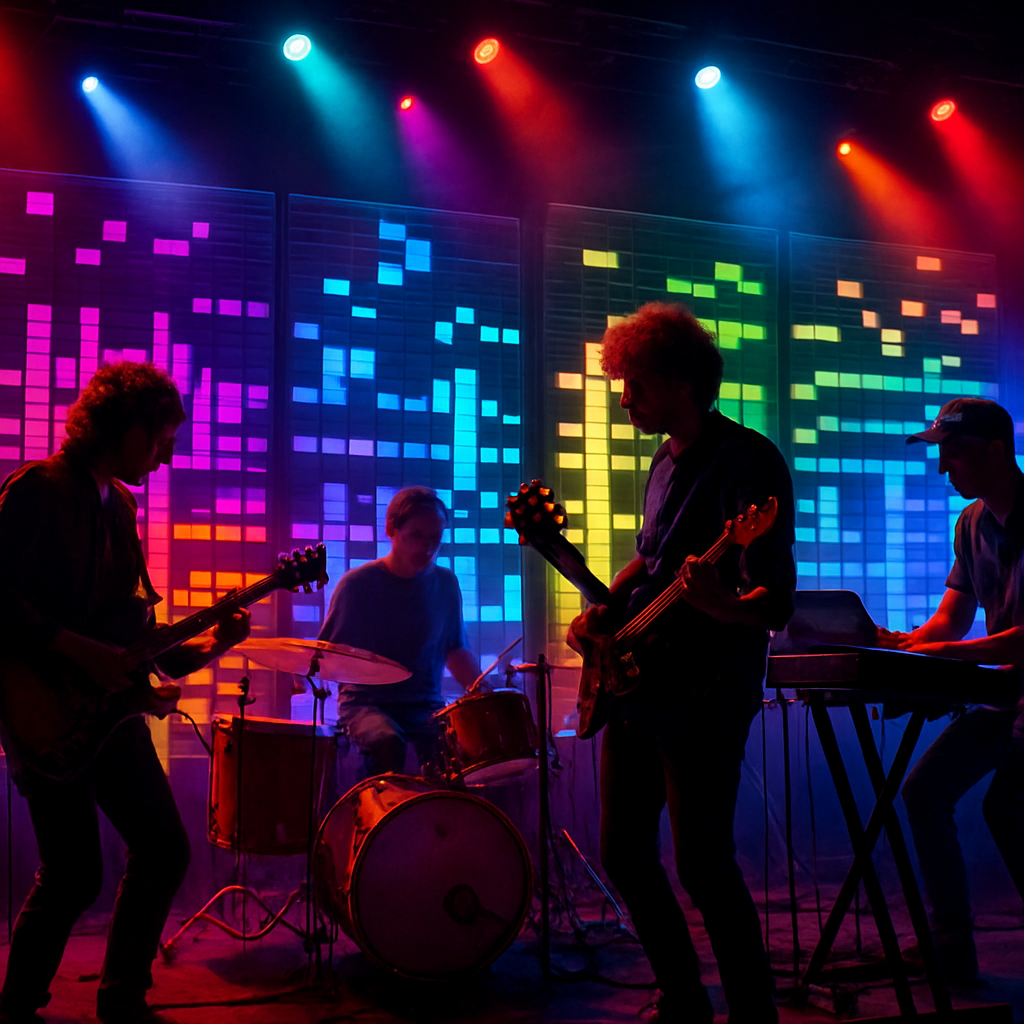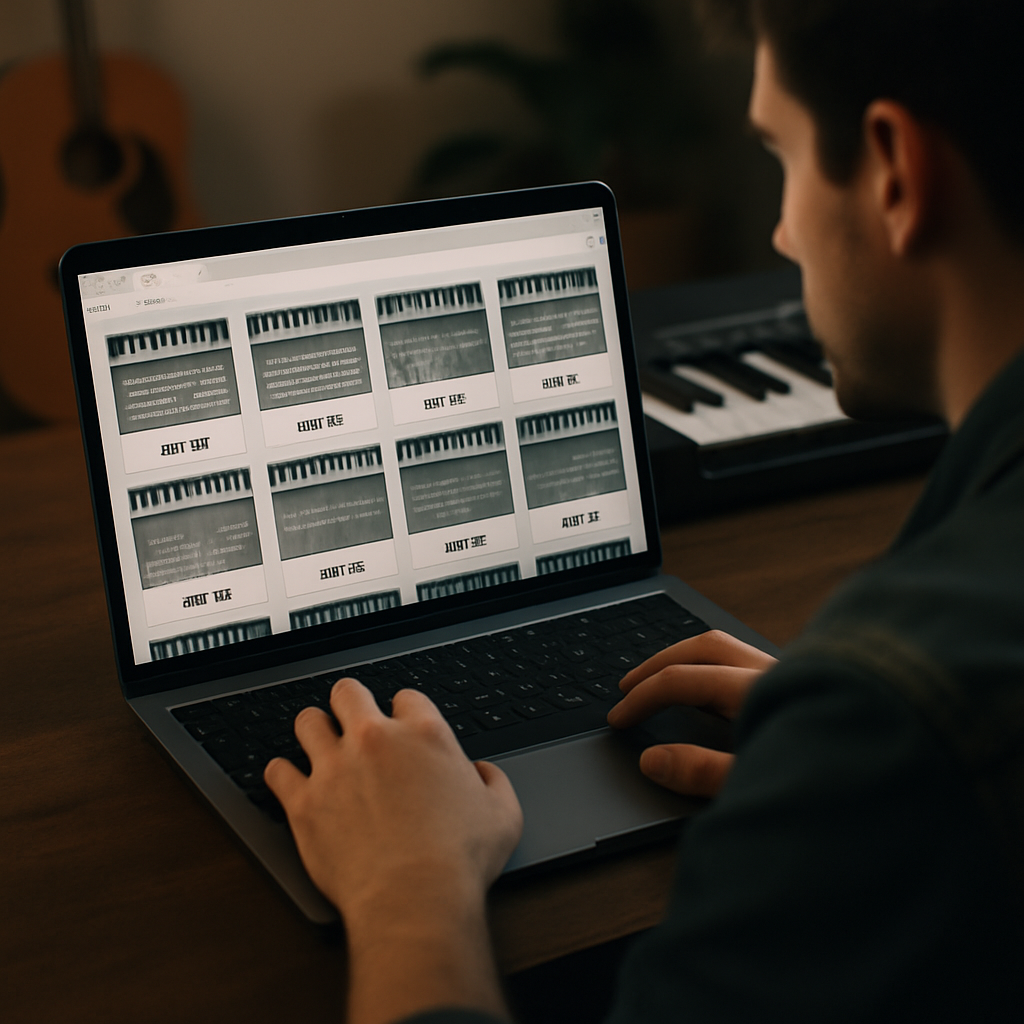Introduction to MIDI Backing Tracks
Definition of MIDI Backing Tracks
So, what exactly are these magical midi accompaniment tracks? In simple terms, they are digital files that provide instrumental support for musicians. Think of them as the virtual band members you’ve always wanted-without the need for snacks or bathroom breaks!
MIDI (Musical Instrument Digital Interface) files contain information about notes, rhythms, and instruments but lack actual audio. This means they can be manipulated, edited, and customized to fit your unique style. From guitar midi backing tracks to piano accompaniment midi files, there's a treasure trove of options available.
Importance in Live Performances
The role of midi file backing tracks in live performances cannot be overstated. They elevate your sound quality and depth while allowing you to focus on what you do best-performing! Imagine playing a complex solo while your MIDI track handles the rhythm section. It’s like having your cake and eating it too!
Key Benefits:
- Enhanced sound quality: High-quality MIDI files can mimic professional studio recordings.
- Flexibility: Easily change arrangements on-the-fly.
- Cost-effective: Save on hiring additional musicians.
With options for free midi backing tracks, custom midi backing tracks, and even downloadable midi tracks, there’s something for everyone. Plus, who doesn’t love a good karaoke session? With karaoke midi files, you can turn any song into a sing-along hit!
Brief Overview of Their Evolution in Music
The evolution of MIDI technology has revolutionized music production and performance since its inception in the early 1980s. Initially used primarily in studios, it has now found its way into live performances across genres-from rock music backing in MIDI format to jazz standards in MIDI format.
The use of MIDI technology has revolutionized the way music is produced and performed. - Electronic Musician - Source
This transformation has made it easier for musicians at all levels to access high-quality sounds without breaking the bank. Today, artists can find everything from studio quality midi files for polished performances to editable midi backing tracks that allow for personal flair.
If you're ready to dive into this exciting realm of virtual music-making, stay tuned! In the upcoming sections, we will explore how you can effectively use these tools in your live performances and take your musical game to new heights!

Benefits of Using MIDI Backing Tracks in Live Performances
Enhanced Sound Quality and Depth
One of the standout perks of using midi backing tracks is the enhanced sound quality. High-quality MIDI files can replicate the richness of professional studio recordings, giving your live performances a polished edge. Imagine your audience being enveloped in lush harmonies and intricate layers, all while you focus on delivering an unforgettable show!
It’s like having a full orchestra at your fingertips without needing to book a venue big enough to fit them all. With high quality midi backing tracks, you can create an immersive experience that captivates your listeners.
Flexibility in Arrangements
MIDI technology offers incredible flexibility when it comes to arrangements. You can tweak, edit, and rearrange your midi file backing tracks on-the-fly, making it easy to adapt to different performance scenarios. Want to extend that guitar solo? No problem! Need to add a bridge? Just click a few buttons!
This adaptability is especially beneficial for live performers who thrive on spontaneity. Plus, with access to custom midi backing tracks, you can create unique arrangements that reflect your personal style or even cater to specific gigs.
Ability to Play Complex Parts Without Additional Musicians
If you've ever dreamed of playing complex arrangements without needing a small army of musicians, midi accompaniment tracks are here to save the day! Whether it's intricate drum patterns or lush string sections, MIDI allows you to incorporate these elements seamlessly into your performance.
This means you can handle solos and vocals while your MIDI track takes care of the rest. It’s like having a virtual band that never misses a beat-no rehearsals required! As noted by Keyboard Magazine, “MIDI allows musicians to create complex arrangements with minimal equipment.” This opens up endless possibilities for solo artists and bands alike.
Cost-Effectiveness for Bands and Solo Artists
Let’s talk money-because who doesn’t love saving some cash? Hiring additional musicians can be expensive, but with midi backing tracks, you get top-notch sound without breaking the bank. Whether you're looking for drumless backing tracks in midi format or need some killer popular song midi files, there are plenty of affordable options available.
Cost-Saving Tips:
- Explore free midi backing tracks: Great for practice or testing out new ideas.
- Invest in professional midi backing tracks: A small price for big sound!
- Utilize online midi backing tracks: Instant access without any shipping fees!
This cost-effectiveness makes MIDI an attractive option for both budding musicians and seasoned pros looking to maximize their budget while still delivering memorable performances.
If you're not already using live performance midi tracks, what are you waiting for? Dive into this world of endless possibilities and elevate your performances today!

Choosing the Right MIDI Backing Tracks
Navigating the world of midi backing tracks can feel like trying to pick the best ice cream flavor at a parlor with dozens of options. Do you go for classic vanilla, or do you dare to try something exotic? Similarly, choosing the right MIDI tracks for your live performances requires careful consideration and a bit of adventurous spirit. Let’s dig into how to find the perfect tracks that will elevate your music game!
Factors to Consider When Selecting Tracks
Before you hit that download button on downloadable midi tracks, here are some key factors to keep in mind:
- Genre Compatibility: Ensure the track fits your musical style. Are you jamming out rock music backing in MIDI format or going smooth with jazz standards in MIDI format? Choose wisely!
- Quality Matters: Look for high quality midi backing tracks. The last thing you want is a track that sounds like it was recorded in a tin can.
- Editability: Opt for editable midi backing tracks. This allows you to customize arrangements and make them uniquely yours.
- Performance Needs: Consider whether you'll need complex parts like drumless backing tracks in midi format or simple piano accompaniment midi files. Tailor your selection based on what enhances your performance.
- File Format: Make sure the files are compatible with your setup. If you're using software like Synthesia, check for synthesia compatible midi files.
Where to Find High-Quality MIDI Files
The internet is a treasure trove of resources when it comes to finding midi file backing tracks. Here are some top spots to score those golden nuggets:
- MIDI Marketplaces: Websites like CYBERMIDI offer a vast selection of professional midi backing tracks tailored for various genres.
- YouTube Channels: Some channels provide free midi backing tracks along with tutorials on how to use them effectively.
- MIDI Forums and Communities: Engage with fellow musicians who might share their favorite resources or even custom midi files they’ve created.
- Songs Libraries: Explore libraries that offer popular song midi files which can be a great addition to your setlist!
Pro Tip:
If you're just starting out, don’t overlook free midi backing tracks. They can be perfect for practice sessions as you hone your skills and experiment with different styles!
Understanding Licensing and Usage Rights
This is where things can get tricky, so pay attention! Not all midi music tracks come with the same usage rights. Here’s what you need to know before unleashing those beats on stage:
- Royalty-Free vs. Licensed Tracks: Ensure you understand whether the track is royalty-free or if it requires a license for public performance.
- User Agreements: Read through any agreements before purchasing or downloading. Some might restrict how you can use the track (like not allowing alterations).
- Citation Requirements: Some creators may require credit when using their work, especially if it's shared publicly.
Navigating licensing can feel like reading legal jargon from an ancient scroll, but taking the time to understand these details will save headaches down the line!
If you're ready to take your live performances up a notch, remember that selecting the right midi backing tracks, understanding their quality, and knowing where they come from is crucial. So go ahead-explore, experiment, and let those virtual bandmates shine!

Creating Your Own MIDI Backing Tracks
Software Options for Creating MIDI Tracks
Ready to unleash your inner musical wizard? The first step is choosing the right software to create your midi backing tracks. Here’s a quick rundown of some popular options:
- GarageBand: Perfect for Mac users, this user-friendly software offers a range of tools for composing custom midi backing tracks.
- FL Studio: A favorite among electronic music producers, this DAW allows you to craft intricate editable midi backing tracks.
- Ableton Live: Ideal for live performances, it lets you manipulate MIDI in real-time, making it easier to integrate with your set.
- Cakewalk by BandLab: A free option that doesn’t skimp on features-great for those just starting out!
- Sibelius or Finale: If you're more into notation, these programs are excellent for composing and exporting instrumental midi files.
No matter which software you choose, ensure it supports the creation of high quality midi backing tracks. This will make all the difference when you're on stage!
Tips for Composing Effective Backing Tracks
Now that you've got your software ready, let’s talk composition! Crafting effective MIDI tracks is an art form. Here are some tips to help you write tracks that not only sound great but also enhance your performance:
- Keep It Simple: Start with a strong foundation-basic chord progressions and rhythms will give you room to build complexity later.
- Add Layers Gradually: Introduce instruments one at a time. This helps maintain clarity and allows each layer to shine.
- Use Dynamics Wisely: Incorporate volume changes and articulation to add emotional depth. Think of it as seasoning your dish; too much can overpower the flavor!
- Mimic Real Instruments: When creating midi music tracks, try using sounds that mimic real instruments closely. This adds authenticity and richness.
- Avoid Overcrowding: Less is often more. Avoid cramming too many elements into one track; let each part breathe!
If you're unsure where to start, consider analyzing popular song midi files for inspiration. You'll see how successful artists structure their arrangements!
Integrating Live Instruments with MIDI Tracks
The magic happens when you blend live instruments with your live performance midi tracks. Here are some strategies to ensure seamless integration:
- Create a Cue System: Use visual cues or backing vocal prompts from your MIDI track to keep everything in sync during performances.
- Synchronize Tempo: Ensure that both live musicians and MIDI files are locked in at the same tempo. A metronome can be your best friend here!
- Add Variation: Use MIDI tracks as a base but encourage improvisation from live musicians. This keeps performances fresh and exciting!
- Panning Techniques: Experiment with panning in your mix. For example, if you're using a drum machine alongside a live drummer, pan them slightly apart for clarity.
- A/B Testing in Rehearsals: During rehearsals, test different combinations of live vs. MIDI sounds to find the perfect balance.
Dive into this integration process like it's a dance-off! The more comfortable you become blending live instruments with midi accompaniment tracks, the more dynamic your performances will be.
Your Takeaway:
Create unique virtual band tracks, experiment freely, and don’t hesitate to let those creative juices flow! The world of MIDI is vast-explore it fully!

Setting Up Your Performance with MIDI Backing Tracks
Ready to take your live performances to the next level with midi backing tracks? Great! But before you dive into the spotlight, let’s make sure you have your tech game on point. Here’s how to set up for success!
Equipment Needed for Live Performances with MIDI Tracks
First things first, let’s talk gear. You wouldn’t show up to a race in flip-flops, right? Similarly, having the right equipment is crucial for a seamless performance. Here’s what you’ll need:
- MIDI Controller: This is your magic wand! It allows you to trigger and manipulate your midi file backing tracks. Look for one that feels comfortable and has all the knobs and pads you need.
- Laptop or Tablet: A reliable device to run your MIDI software. Make sure it has enough processing power because nobody wants a laggy performance!
- Audio Interface: This will help connect your MIDI controller and any live instruments to your sound system, ensuring high-quality output.
- Speakers or PA System: You want your audience to hear every note crystal clear. Invest in a good PA system that can handle the dynamic range of your tracks.
- Cables and Adapters: Don’t forget these little guys! Having the right cables ensures everything connects smoothly (and no one likes scrambling around mid-performance).
If you're unsure about what specific models or types to get, check out reviews online or ask fellow musicians for their recommendations!
Troubleshooting Common Technical Issues
No one wants a tech meltdown during a show! Here are some common issues you might encounter with midi backing tracks, along with tips on how to troubleshoot them:
- No Sound? Double-check connections and ensure that your audio interface is properly set up. Also, make sure the volume levels are appropriate-sometimes it’s just muted!
- Lag or Latency? This can be caused by too many plugins running on your laptop. Close any unnecessary applications before performing.
- MIDI Not Responding? Verify that all devices are connected correctly and that the software recognizes them. Sometimes a simple restart can work wonders!
- Poor Quality Playback? Ensure you're using high quality midi backing tracks. If they sound bad in rehearsal, they’ll sound worse on stage.
If all else fails, have a backup plan-whether it’s an acoustic version of your set or just some good old-fashioned crowd interaction!
Cueing and Syncing with Your Performance Style
Cueing is like being the conductor of an orchestra where every musician is virtual-except they don’t always play nice if not synced properly! Here are some strategies to keep everything grooving together:
- Create Visual Cues: Use lights or visual signals from your MIDI software as prompts for when to start playing certain parts. This helps maintain timing without relying solely on ear cues.
- Synchronize Tempo: Make sure both live instruments and MIDI tracks are locked into the same tempo. A metronome can be invaluable here-think of it as your musical heartbeat!
- Add Personal Touches: Feel free to improvise over the MIDI tracks! Your unique flair will keep performances fresh and engaging.
- Panning Techniques: Experiment with panning different sounds within your mix; this creates space and clarity in live settings where multiple sounds compete for attention.
Your setup should feel like an extension of yourself-not just another piece of gear! The more naturally you integrate live performance midi tracks, the more dynamic and enjoyable your shows will be.
Your Takeaway:
The right equipment combined with troubleshooting know-how will set you up for success. Embrace technology as an ally in creating unforgettable performances!
Case Studies: Successful Use of MIDI Backing Tracks in Live Performances
Anecdotes from Bands and Solo Artists Using MIDI Effectively
Let’s kick things off with some real-world examples that showcase how midi backing tracks have transformed live performances. Take the indie band “Electric Echoes,” for instance. They started using custom midi backing tracks to fill out their sound during live shows. By integrating a MIDI drum machine, they could focus on their vocals and guitar solos while the rhythm section pulsed seamlessly behind them. Their audience? Absolutely electrified!
Then there’s solo artist “Melody Star.” She uses professional midi backing tracks for her acoustic sets, allowing her to perform intricate arrangements without needing a full band. Her secret? A carefully curated selection of high quality midi backing tracks that complement her voice beautifully, creating an intimate yet powerful experience for her fans.
Diverse Genres That Benefit from MIDI Backing Tracks
MIDI isn’t just for one genre; it’s a versatile tool that spans across musical styles! From rock music backing in MIDI format to classical music midis for practice, artists are leveraging these tracks to enhance their performances. For instance:
- Jazz Musicians: Many jazz artists use jazz standards in midi format to practice improvisation and explore new arrangements without needing a full ensemble.
- Pop Artists: Cover bands often utilize pop song midis for cover bands, allowing them to replicate the sound of popular hits with precision.
- Country Musicians: Country singers frequently incorporate country music midis for singers and musicians alike, which helps them maintain the genre's signature sound while performing solo.
- Blues Artists: Blues musicians benefit greatly from blues track in midi file format, providing a rich backdrop for soulful solos.
This diversity illustrates how adaptable midi accompaniment tracks can be, making them essential tools across genres!
Learner Insights from Music Educators and Students Using These Tools in Practice Sessions or Performances
The educational realm has also seen significant advantages from using midi file backing tracks. Music educators are increasingly incorporating these resources into their teaching methods. For example, a local music school has adopted editable midi backing tracks as part of their curriculum, enabling students to practice alongside high-quality accompaniments tailored to their skill levels.
A student named Jake shared his experience: “Using instrumental midi files during my practice sessions has helped me improve my timing and confidence when performing live. It feels like I’m jamming with a band!” This sentiment resonates with many learners who find that practicing with MIDI not only enhances their skills but also makes the process more enjoyable.
The Takeaway:
MIDI backing tracks are not just tools-they're game changers! Whether you’re a seasoned performer or a budding musician, integrating these resources can elevate your live performances and practice sessions alike.
The Future of Live Performances with Technology and MIDI Backing Tracks
As we peer into the crystal ball of music, one thing becomes clear: the future of live performances is intertwined with technology and midi backing tracks. Imagine a world where every musician has access to a virtual band at their fingertips, ready to enhance their sound and elevate their performance. Sounds dreamy, right? Well, it’s already happening!
Embracing Virtual Reality and Augmented Reality
With advancements in virtual reality (VR) and augmented reality (AR), musicians can now create immersive experiences that blend live performances with stunning visuals. Picture this: you’re jamming on stage while holographic musicians join you, all synced perfectly through midi file backing tracks. This isn’t just science fiction; it’s becoming a reality!
By incorporating AR elements into live shows, artists can engage audiences in ways never seen before. You could use downloadable midi tracks combined with AR visuals to create an unforgettable atmosphere that enhances the emotional impact of your performance.
The Rise of AI-Generated MIDI Tracks
Artificial intelligence is making waves in music production, and it’s only a matter of time before AI-generated midi accompaniment tracks become mainstream. Imagine software that analyzes your playing style and generates personalized custom midi backing tracks tailored just for you! This technology can help musicians write better songs faster and explore new creative avenues.
However, while AI can be a powerful tool for generating ideas or enhancing compositions, nothing beats the human touch in live performances. The key will be finding the perfect balance between technology and artistry.
The Evolution of Live Streaming with MIDI Integration
The pandemic accelerated the shift toward live streaming performances, and this trend is here to stay. Musicians are now leveraging platforms like Twitch or YouTube Live to reach global audiences from their living rooms. Integrating live performance midi tracks into these streams allows artists to deliver high-quality sound while engaging viewers through interactive elements.
This opens up new revenue streams for artists as they can perform paid gigs online or offer exclusive content to fans. Plus, who wouldn’t want to watch their favorite artist perform from the comfort of their couch? It’s like having front-row seats without the hefty price tag!
The Democratization of Music Production
The accessibility of high quality midi backing tracks means that musicians from all walks of life can produce studio-quality music without needing expensive equipment. With platforms offering free midi backing tracks, aspiring artists can experiment freely, hone their skills, and create impressive performances without breaking the bank.
This democratization fosters diversity in music as unique voices emerge from unexpected places. It also encourages collaboration among artists who may never have met otherwise-think about how many amazing projects could come from connecting through shared MIDI files!
Your Takeaway:
The future looks bright for live performances! By embracing technology like AI-generated MIDI tracks, AR experiences, and streaming integration, musicians can elevate their craft while reaching wider audiences than ever before.
Conclusion: Elevating Your Performance with MIDI Backing Tracks
Recap of the Benefits Discussed
As we wrap up this musical journey through the world of midi backing tracks, let’s take a moment to recap the fantastic benefits we've explored:
- Enhanced sound quality: High-quality MIDI files can elevate your live sound to studio-level perfection.
- Flexibility in arrangements: Easily adapt your tracks on-the-fly to fit the vibe of your performance.
- Cost-effectiveness: Save money by reducing the need for additional musicians.
- Access to diverse genres: From jazz standards in midi format to rock music backing in midi format, there's something for every musician.
- Personalization: Create custom midi backing tracks that reflect your unique style and artistry.
Encouragement to Experiment with Different Styles and Techniques
The world of midi accompaniment tracks is vast and ripe for exploration. Don't be afraid to mix things up! Here are some ideas to get you started:
- Dabble in different genres: Try out classical music midis for practice, country music midis for singers and musicians alike, or even some funky pop song midis for cover bands!
- Create drumless backing tracks in midi format: This allows you to focus on your instrument while still having a solid foundation.
- Add layers: Combine various MIDI instruments to craft rich, textured soundscapes that will wow your audience.
- Tweak existing tracks: Use editable midi backing tracks as a base and make them uniquely yours!
- Collaborate with others: Share your custom creations or find fellow musicians who can offer fresh perspectives on your work.The possibilities are endless, so let your creativity run wild!
Your Takeaway:
MIDI backing tracks are not just tools; they’re gateways to new musical experiences. Embrace them, experiment, and watch as they elevate your performances like never before!


